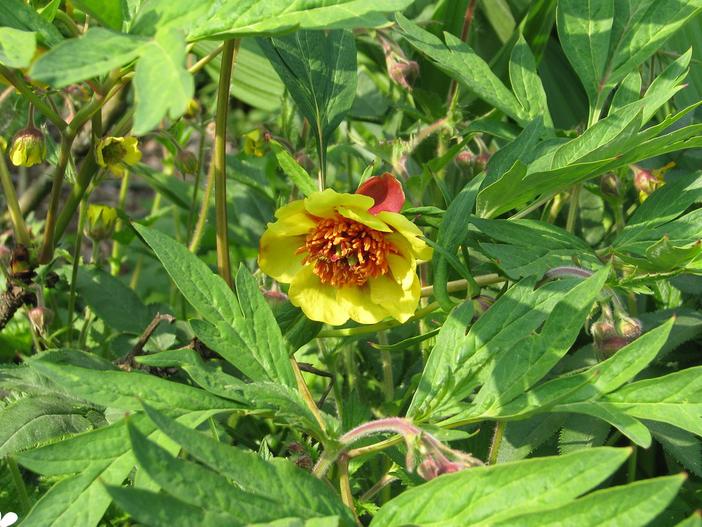Yellow Tree Peony
(Paeonia delavayi subsp. lutea)
Yellow Tree Peony (Paeonia delavayi subsp. lutea)
/
/

peganum
CC BY-SA 2.0
Image By:
peganum
Recorded By:
Copyright:
CC BY-SA 2.0
Copyright Notice:
Photo by: peganum | License Type: CC BY-SA 2.0 | License URL: https://creativecommons.org/licenses/by-sa/2.0/ | Uploader: peganum | Publisher: Flickr


















Estimated Native Range
Summary
Paeonia delavayi subsp. lutea, commonly known as Yellow Tree Peony or Delavay’s Tree Peony, is a deciduous shrub native to the mountainous regions of Western China, particularly in Yunnan province. It is typically found in open woodlands and on sunny slopes, often at high altitudes. This species grows at a moderate rate to a height of 4-6 feet (1.2-1.8 meters) and a width of 4-5 feet (1.2-1.5 meters). The Yellow Tree Peony is characterized by its large, cup-shaped, yellow flowers that bloom in late spring to early summer, providing a showy display that is highly valued in gardens. The foliage is deep green, divided into leaflets, and provides a lush backdrop for the flowers.
The Yellow Tree Peony is appreciated for its striking flowers and is often used in ornamental plantings, as a specimen plant, or in mixed borders. It requires well-drained soil, preferably a loamy or clay substrate, and can tolerate part shade, though it flowers best in full sun. While it needs regular watering, especially during the growing season, it is relatively drought-tolerant once established. This plant is also known for its medicinal properties in traditional Chinese medicine. Gardeners should be aware that it can be susceptible to peony wilt and other fungal diseases, and it may require staking due to the heavy blooms.CC BY-SA 4.0
The Yellow Tree Peony is appreciated for its striking flowers and is often used in ornamental plantings, as a specimen plant, or in mixed borders. It requires well-drained soil, preferably a loamy or clay substrate, and can tolerate part shade, though it flowers best in full sun. While it needs regular watering, especially during the growing season, it is relatively drought-tolerant once established. This plant is also known for its medicinal properties in traditional Chinese medicine. Gardeners should be aware that it can be susceptible to peony wilt and other fungal diseases, and it may require staking due to the heavy blooms.CC BY-SA 4.0
Plant Description
- Plant Type: Shrub
- Height: 4-6 feet
- Width: 4-5 feet
- Growth Rate: Moderate
- Flower Color: Yellow
- Flowering Season: Spring
- Leaf Retention: Deciduous
Growth Requirements
- Sun: Full Sun, Part Shade
- Water: Medium
- Drainage: Medium
Common Uses
Border Plant, Fragrant, Potted Plant, Showy Flowers
Natural Habitat
Native to open woodlands and sunny slopes in mountainous regions of Western China
Other Names
Common Names: Delavay’s Tree Peony
Scientific Names: , Paeonia delavayi subsp. lutea, Paeonia delavayi f. lutea, Paeonia delavayi f. trollioides, Paeonia delavayi var. lutea, Paeonia forrestii var. trollioides, Paeonia lutea, Paeonia lutea, Paeonia potaninii var. trollioides, Paeonia trollioides
GBIF Accepted Name: